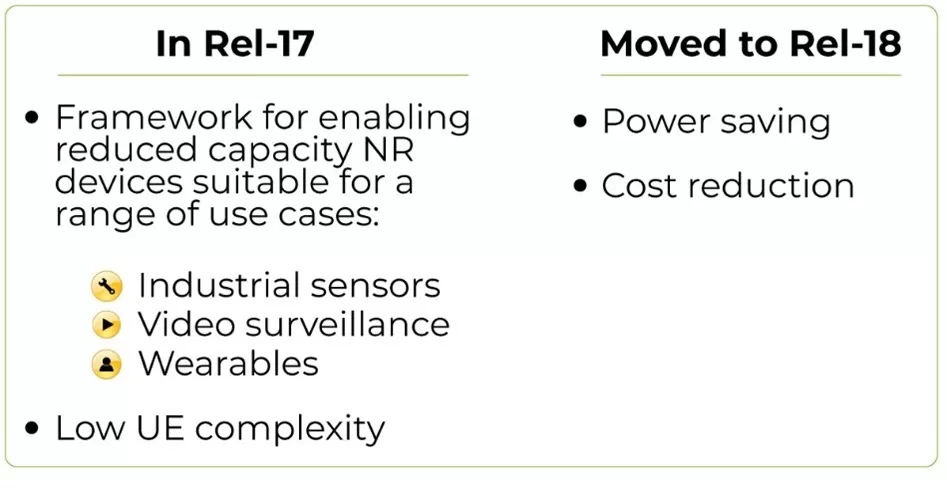Introduction
The evolution to 5G has brought new advancements in data speed, capacity, and latency, enabling a wide range of applications from enhanced mobile broadband to ultra-reliable low-latency communications and massive machine-type communications. Among the various devices supported by 5G, Reduced Capability (RedCap) devices have emerged as an important segment targeting low-cost, and power efficiency for industrial sensors, video surveillance, and wearable technology.
3GPP has been instrumental in defining and refining the standards for mobile communications. In Release 17, 3GPP introduced the framework for RedCap UEs, addressing the needs of low-tier devices by providing NR support with reduced complexity and power consumption requirements. This foundational work established a pathway for supporting diverse use cases requiring efficient and cost-effective connectivity solutions.
Despite the advancements in Release 17, there remains a continuous demand for further optimization of RedCap UEs. As the market for low-tier devices expands, there is a need to enhance their capabilities while maintaining cost and power efficiency.

The study conducted in 3GPP TR 38.865 from Release 18 focuses on exploring additional techniques to further reduce the complexity of RedCap UEs. These enhancements aim to:
- Expand Market Reach: By lowering the barriers to entry, further complexity reduction can make RedCap UEs accessible to a broader range of applications and industries.
- Improve Efficiency: Enhanced techniques can lead to better resource utilization, prolonging battery life and improving device performance.
- Ensure Compatibility: Maintaining coexistence with existing NR devices and networks is crucial to leveraging the full potential of 5G deployments.
Key Techniques for UE Complexity Reduction
The primary objective of the 3GPP TR 38.865 study is to explore and evaluate techniques for further reducing the complexity of RedCap. The specific goals include:
- UE Bandwidth Reduction: Investigating methods to reduce the operational bandwidth of RedCap UEs, thereby lowering their complexity and power consumption while maintaining adequate performance for target applications.
- UE Peak Rate Reduction: Evaluating strategies to limit the peak data rates of RedCap UEs, which can simplify device architecture and reduce costs.
- Relaxed UE Processing Timeline: Assessing the impact of extending processing timelines for downlink (DL) and uplink (UL) transmissions, which can lead to further reductions in device complexity and power requirements.
- Combination of Techniques: Analyzing the combined effects of the above techniques to achieve optimal complexity reduction while ensuring that performance, coverage, and coexistence with existing NR devices are not adversely affected.
These techniques focus on optimizing bandwidth usage, peak data rates, and processing timelines to achieve lower device costs and power consumption without significantly impacting performance. The key techniques explored in the study are as follows:
| Technique | Description | UE Complexity Reduction | Performance Impacts | Coexistence Impacts | Specification Changes |
| Bandwidth Reduction | BW1: 5 MHz RF & baseband BW2: 5 MHz baseband, 20 MHz RF BW3: 5 MHz PDSCH |
Reduces baseband (ADC/DAC, FFT, LDPC, MIMO); minor RF impact | Peak rate ↓, coverage impact in high-frequency bands | BW3 has fewer coexistence issues | BW1/BW2 need major changes; BW3 minimal |
| Peak Rate Reduction | PR1: Relax MCS×NPRB constraint PR2: TBS limited PR3: Max PRBs limited |
Simplifies LDPC, HARQ, UL processing | Meets data rate targets; PR3 impacts coverage | PR3 needs careful channel scheduling | PR1/PR2 minimal; PR3 requires adjustments |
| Processing Timeline Relaxation | PT1: PDSCH/PUSCH time ↑ PT2: CSI time ↑ |
Simplifies receiver, LDPC, MIMO processing | Latency ↑; no impact on peak rates/coverage | Minimal coexistence issues | Minor parameter adjustments |
| Combined Techniques | Mix of bandwidth, peak rate, and timeline reduction | Cumulative baseband/RF reduction | Meets data rate, coverage targets; manageable latency | Integration critical for coexistence | Requires comprehensive updates |
These objectives are aligned with the overarching goal of expanding the market for RedCap UEs by making them more accessible and efficient for a broader range of low-cost, low-power, and low-data-rate applications.
Analysis of performance impacts
Peak Data Rate:
Reducing UE bandwidth directly decreases the peak data rate. Despite this reduction, the targeted data rate for Release 18 is still achievable. With a 5 MHz UE bandwidth across all options, the peak data rate for uplink (UL) or downlink (DL) in TDD configurations may drop below 10 Mbps, depending on the TDD pattern. However, this remains sufficient for most RedCap applications.
Coverage:
The reduction in bandwidth has a minor impact on coverage, particularly for the SIB1 PDSCH when the allocated bandwidth exceeds 5 MHz. In most scenarios, including those under 4 GHz with 24 dBm power spectral density (PSD), coverage remains largely unaffected. Some degradation is observed for PDCCH in BW1/BW2 due to the reduced maximum aggregation level in a 5 MHz CORESET, as well as for PBCH at 30 kHz subcarrier spacing (SCS). These impacts are generally manageable within the design parameters of RedCap UEs.
Latency:
The effect of reduced bandwidth on latency is minimal. A 5 MHz UE bandwidth is sufficient to meet the relaxed latency requirements of RedCap use cases, ensuring that devices can operate within the expected performance envelope without significant delays.
This analysis underscores that while reducing complexity through bandwidth, peak rate, and processing timeline adjustments may lead to slight performance trade-offs, these are within acceptable limits for RedCap UEs and do not significantly hinder their intended applications.
Power Consumption Analysis of RedCap UEs
Power efficiency is a key factor in the design and deployment of RedCap. The reduction in complexity inherently impacts power consumption.
| Feature | 5G | 5G RedCap | 5G eRedCap |
| Launch Date | H1 2019 | H1 2023 | H2 2024 |
| Bandwidth | Up to 100 MHz | 20 MHz | 5 MHz |
| Peak Data Rate | 2 Gbps | 100 Mbps | 10 Mbps |
| Device Complexity | High | Medium | Low |
| Battery Life | Medium | Medium | Long |
| Power Consumption | High | Medium | Low |
| Primary Use Cases | Enhanced mobile broadband, Ultra-reliable low latency communications | IoT, industrial automation, smart surveillance | IoT, wearable technology, energy-efficient applications |
| Latency | Ultra-low | Low | Low |
| Processing Efficiency | High (Optimized for speed) | Moderate (Optimized for balance) | High (Optimized for energy efficiency) |
This table highlights the evolution of 5G technology from standard 5G to 5G RedCap and the 5G eRedCap with reduced complexity and efficiency enhancements. 5G eRedCap takes it further by minimizing bandwidth and power consumption, making it ideal for IoT and energy-efficient applications. These advancements extend battery life and broaden the range of use cases, positioning 5G eRedCap as a key technology for the next generation of low-power, high-efficiency devices.
Impact of Bandwidth Reduction on Power Consumption
Reducing the operational bandwidth for the case of 5G eRedCap, as explored in the study, directly influences power consumption.
By limiting the bandwidth to 5 MHz, as proposed in the BW1, BW2, and BW3 options, the power requirements for both RF and baseband processing are significantly reduced. The key factors contributing to power savings include:
- Lower Data Processing Requirements: Narrower bandwidth reduces the amount of data that needs to be processed by the baseband components, leading to lower power usage.
- Reduced RF Chain Activity: With a smaller bandwidth, fewer resources are allocated for RF transmission and reception, minimizing the active power required for these operations.
Studies indicate that reducing the bandwidth can lead to a power savings of up to 30%, depending on the specific use case and device configuration.
Power Implications of Peak Rate Reduction
The strategies for limiting the peak data rates of RedCap, particularly through the PR1, PR2, and PR3 options, also contribute to power efficiency. Limiting peak rates reduces the demand on processing units, particularly during high data throughput scenarios. This reduction is critical in maintaining lower power profiles in devices that operate under stringent power constraints, such as battery-operated IoT devices.
- Lower Peak Power Demand: By capping the maximum data rate, the peak power demand during data transmission and reception is reduced, which is crucial for maintaining consistent power consumption over time.
- Power Optimization for Idle States: Peak rate reduction strategies also optimize power consumption during idle states by ensuring that the device does not consume excessive power when high data rates are not required.
Power Consumption and Relaxed Processing Timelines
Relaxing processing timelines, as explored in the PT1 and PT2 options, allows for extended periods between processing tasks, which can lead to significant power savings. This approach is particularly beneficial in applications where latency is not critical, and the device can afford to process data at a slower pace.
- Energy Efficiency in Low-Data-Rate Applications: For low-data-rate applications, relaxed processing timelines ensure that the device spends less time in active processing states, thereby conserving energy.
- Impact on Device Sleep Cycles: Extending processing timelines allows devices to enter low-power sleep states more frequently, further enhancing battery life.
Conclusions and Recommendations
The study on NR RedCap UE complexity reduction in Release 18 offers a clear approach to reducing device complexity while maintaining critical performance standards. This is done by examining techniques such as bandwidth reduction, peak rate limitation, and relaxed processing timelines.
The reduction leads to significant savings in cost and power consumption, which are crucial for making RedCap devices more accessible for a broader range of low-tier applications. Despite the simplification, the impact on performance metrics—such as peak data rate, coverage, and latency—is minimal. The study’s evaluation demonstrates that these techniques maintain performance within acceptable limits, ensuring that RedCap UEs continue to fulfill the requirements of most deployment scenarios.
Furthermore, the study highlights that RedCap UEs can maintain robust coverage across diverse deployment environments, including both urban and rural settings. With appropriate configuration and scheduling, potential coverage impacts can be effectively managed, ensuring reliable operation. Compatibility with legacy NR devices is generally not a significant issue; however, some strategies, like BW3 and PR3, require careful planning to ensure seamless coexistence with existing UEs. This underscores the importance of early integration and careful planning.
Implementing these complexity reduction techniques will necessitate updates to 3GPP specifications. These updates must be harmonized to align with overall system requirements, ensuring the continued integrity and reliability of 5G NR networks. Overall, the study provides a comprehensive framework for advancing the capabilities of RedCap devices while striking a balance between reducing complexity and maintaining performance. These insights are essential for expanding the market reach of RedCap UEs, positioning them as viable options for a wider range of low-cost, low-power applications in the evolving 5G ecosystem
References
- 3GPP TR 38.865, “Study on further NR RedCap UE complexity reduction (Release 18),” 2023.
- Moloudi, Saeedeh & Mozaffari, Mohammad & Veedu, Sandeep & Kittichokechai, Kittipong & Wang, Y.-P & Bergman, Johan & Hoglund, Andreas. (2021). Coverage Evaluation for 5G Reduced Capability New Radio (NR-RedCap). IEEE Access. PP. 1-1. 10.1109/ACCESS.2021.3066036.
- 3GPP TR 38.875, “Study on Support of Reduced Capability NR Devices (Release 17),” 2021.

